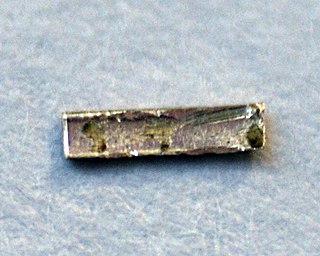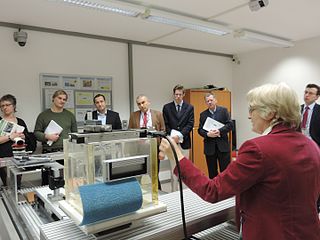External links
| | This standards- or measurement-related article is a stub. You can help Wikipedia by expanding it. |
ISO 31-10 is the part of international standard ISO 31 that defines names and symbols for quantities and units related to nuclear reactions and ionizing radiations . It gives names and symbols for 70 quantities and units. Where appropriate, conversion factors are also given. The standard was withdrawn in 2009 and replaced by ISO 80000-10.
Its definitions include:
| Quantity | Unit | Remarks | ||||
|---|---|---|---|---|---|---|
| Name | Symbol | Definition | Name | Symbol | Definition | |
| ⋮ | ||||||
| activity | A | Expectation value of the number of spontaneous nuclear transitions from a particular energy state occurring in an amount of radionuclide in a small time interval, divided by that time interval | becquerel | Bq | 1 Bq = 1/s | The becquerel is a special name for second to the power minus one, to be used as the SI unit of activity. curie: 1 Ci = 3.7×1010 Bq (exactly) |
| ⋮ | ||||||
| absorbed dose | D | For any ionizing radiation, the mean energy imparted to an element of irradiated matter divided by the mass of this element | gray | Gy | 1 Gy = 1 J/kg | The gray is a special name for joule per kilogram, to be used as the SI unit for absorbed dose. rad: 1 rad = 0.01 Gy |
| dose equivalent | H | Product of D, Q and N, at the point of interest in tissue, where D is the absorbed dose, Q is the quality factor and N is the product of any other modifying factors H = D · Q · N For Q and N, see CIPM, 1984, Recommendation 1 and ICRU Report 33 (1980) | sievert | Sv | 1 Sv = 1 J/kg | The sievert is a special name for joule per kilogram, to be used as the SI unit for dose equivalent. rem: 1 rem = 0.01 Sv |
| ⋮ | ||||||

In physics, radiation is the emission or transmission of energy in the form of waves or particles through space or a material medium. This includes:

Radiometry is a set of techniques for measuring electromagnetic radiation, including visible light. Radiometric techniques in optics characterize the distribution of the radiation's power in space, as opposed to photometric techniques, which characterize the light's interaction with the human eye. The fundamental difference between radiometry and photometry is that radiometry gives the entire optical radiation spectrum, while photometry is limited to the visible spectrum. Radiometry is distinct from quantum techniques such as photon counting.

The sievert is a unit in the International System of Units (SI) intended to represent the stochastic health risk of ionizing radiation, which is defined as the probability of causing radiation-induced cancer and genetic damage. The sievert is important in dosimetry and radiation protection. It is named after Rolf Maximilian Sievert, a Swedish medical physicist renowned for work on radiation dose measurement and research into the biological effects of radiation.

The curie is a non-SI unit of radioactivity originally defined in 1910. According to a notice in Nature at the time, it was to be named in honour of Pierre Curie, but was considered at least by some to be in honour of Marie Curie as well, and is in later literature considered to be named for both.

The becquerel is the unit of radioactivity in the International System of Units (SI). One becquerel is defined as an activity of one decay per second. For applications relating to human health this is a small quantity, and SI multiples of the unit are commonly used.
Ionizing radiation, including nuclear radiation, consists of subatomic particles or electromagnetic waves that have sufficient energy to ionize atoms or molecules by detaching electrons from them. Some particles can travel up to 99% of the speed of light, and the electromagnetic waves are on the high-energy portion of the electromagnetic spectrum.
The gray is the unit of ionizing radiation dose in the International System of Units (SI), defined as the absorption of one joule of radiation energy per kilogram of matter.

Radiation dosimetry in the fields of health physics and radiation protection is the measurement, calculation and assessment of the ionizing radiation dose absorbed by an object, usually the human body. This applies both internally, due to ingested or inhaled radioactive substances, or externally due to irradiation by sources of radiation.
ISO 31 is a superseded international standard concerning physical quantities, units of measurement, their interrelationships and their presentation. It was revised and replaced by ISO/IEC 80000.

Hazard symbols are recognizable symbols designed to warn about hazardous or dangerous materials, locations, or objects, including electromagnetic fields, electric currents; harsh, toxic or unstable chemicals ; and radioactivity. The use of hazard symbols is often regulated by law and directed by standards organizations. Hazard symbols may appear with different colors, backgrounds, borders, and supplemental information in order to specify the type of hazard and the level of threat. Warning symbols are used in many places in place of or in addition to written warnings as they are quickly recognized and more universally understood, as the same symbol can be recognized as having the same meaning to speakers of different languages.
The roentgen equivalent man (rem) is a CGS unit of equivalent dose, effective dose, and committed dose, which are dose measures used to estimate potential health effects of low levels of ionizing radiation on the human body.
Absorbed dose is a dose quantity which is the measure of the energy deposited in matter by ionizing radiation per unit mass. Absorbed dose is used in the calculation of dose uptake in living tissue in both radiation protection, and radiology. It is also used to directly compare the effect of radiation on inanimate matter such as in radiation hardening.
The rad is a unit of absorbed radiation dose, defined as 1 rad = 0.01 Gy = 0.01 J/kg. It was originally defined in CGS units in 1953 as the dose causing 100 ergs of energy to be absorbed by one gram of matter. The material absorbing the radiation can be human tissue, air, water, or any other substance.
ISO 31-0 is the introductory part of international standard ISO 31 on quantities and units. It provides guidelines for using physical quantities, quantity and unit symbols, and coherent unit systems, especially the SI. It was intended for use in all fields of science and technology and is augmented by more specialized conventions defined in other parts of the ISO 31 standard. ISO 31-0 was withdrawn on 17 November 2009. It is superseded by ISO 80000-1. Other parts of ISO 31 have also been withdrawn and replaced by parts of ISO 80000.
ISO 31-6 is the part of international standard ISO 31 that defines names and symbols for quantities and units related to light and related electromagnetic radiations. It is superseded by ISO 80000-7.
ISO 31-8 is the part of international standard ISO 31 that defines names and symbols for quantities and units related to physical chemistry and molecular physics.
ISO 80000 or IEC 80000, Quantities and units, is an international standard describing the International System of Quantities (ISQ). It was developed and promulgated jointly by the International Organization for Standardization (ISO) and the International Electrotechnical Commission (IEC). It serves as a style guide for using physical quantities and units of measurement, formulas involving them, and their corresponding units, in scientific and educational documents for worldwide use. The ISO/IEC 80000 family of standards was completed with the publication of the first edition of Part 1 in November 2009.

The International System of Quantities (ISQ) is a standard system of quantities used in physics and in modern science in general. It includes basic quantities such as length and mass and the relationships between those quantities. This system underlies the International System of Units (SI) but does not itself determine the units of measurement used for the quantities.
In radiobiology, the relative biological effectiveness is the ratio of biological effectiveness of one type of ionizing radiation relative to another, given the same amount of absorbed energy. The RBE is an empirical value that varies depending on the type of ionizing radiation, the energies involved, the biological effects being considered such as cell death, and the oxygen tension of the tissues or so-called oxygen effect.

The roentgen or röntgen is a legacy unit of measurement for the exposure of X-rays and gamma rays, and is defined as the electric charge freed by such radiation in a specified volume of air divided by the mass of that air . In 1928, it was adopted as the first international measurement quantity for ionizing radiation to be defined for radiation protection, as it was then the most easily replicated method of measuring air ionization by using ion chambers. It is named after the German physicist Wilhelm Röntgen, who discovered X-rays and was awarded the first Nobel Prize in Physics for the discovery.